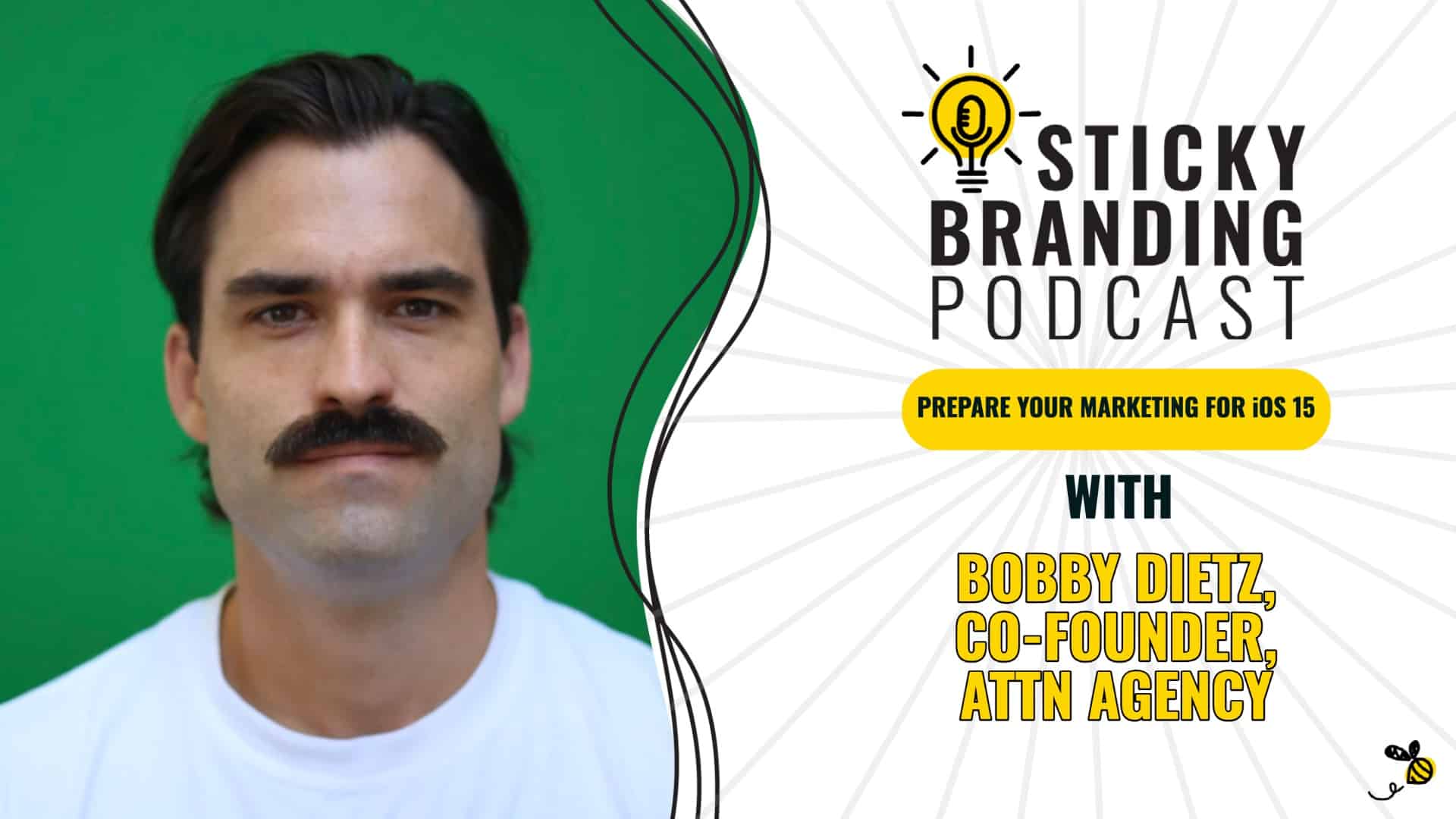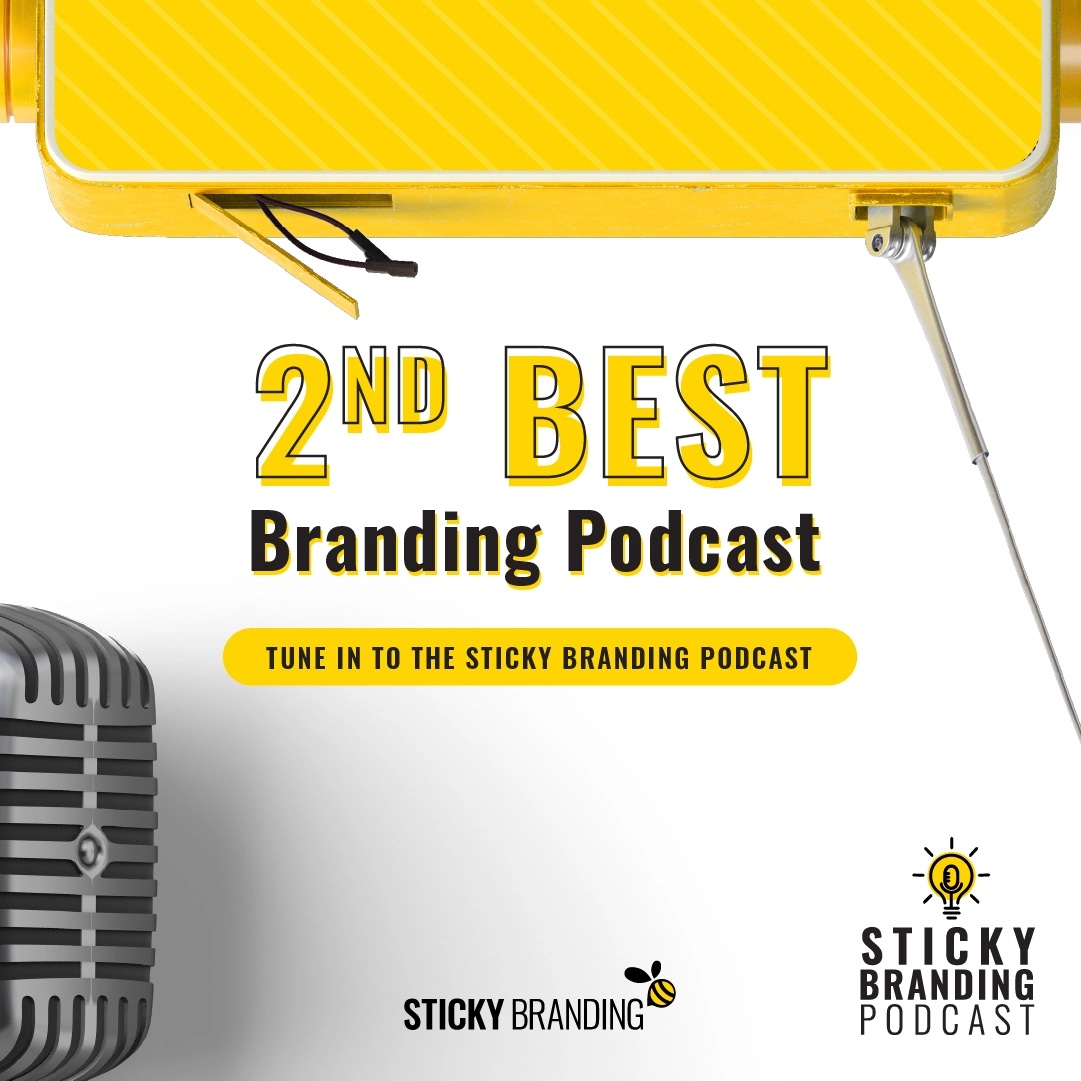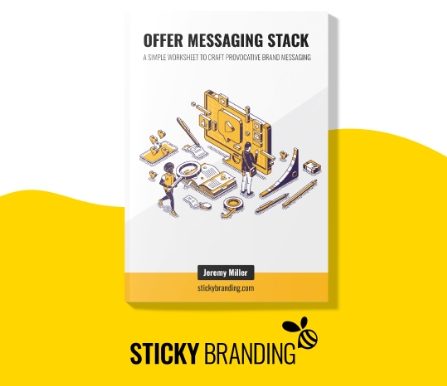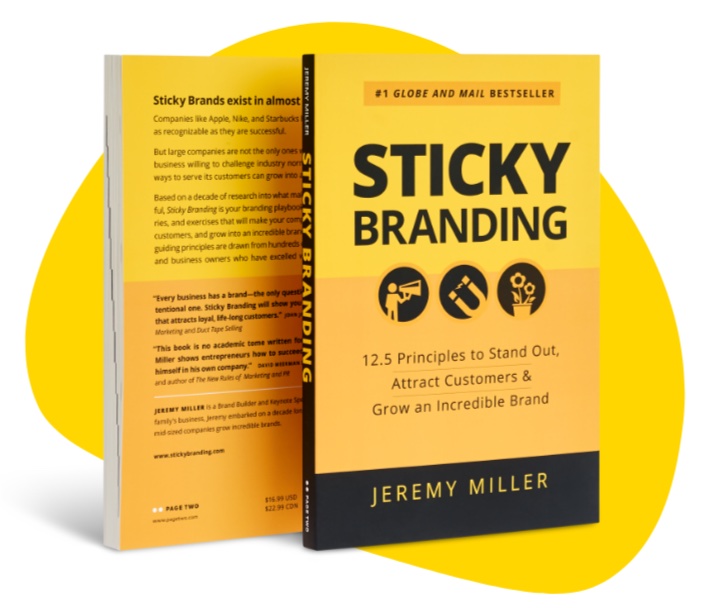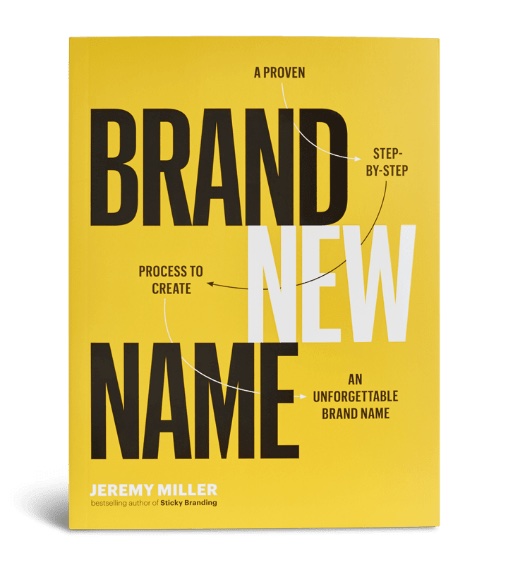– Brand X, brand Y, brand Z. Not one sticks. Watch it again in slow motion.
– [Jeremy] Welcome to the Sticky Branding Podcast. In this show, we are unpacking how companies grow Sticky Brands. My name is Jeremy Miller. I am the founder of Sticky Branding, and host of the show. Today, I’m very excited to introduce you to Bobby Deitz. Bobby is a co-founder and partner in the digital advertising agency, the ATTN Agency. Bobby, welcome to the show.
– Thank you very much for having me. It’s an absolute pleasure. Big fan of all your works, especially your books, and I’m looking forward to chatting a little more about marketing today.
– Me too, so let’s just dive into the deep end. Tell me about ATTN Agency.
– Yup. Who are you guys and what you do?
– Sure, yeah. Founded by four partners, all that were pretty heavily involved in digital marketing, anywhere from eight to ten years. We had a plethora of experience from, you know, affiliate marketing to consumer good ownership to software sales and creation. And now we have taken all those skills ,as of three plus years ago, and kind of directed them into performance marketing as a performance marketing agency. We formed ATTN Agency and more or less started without any real experience in, you know, proper ad agency operations and having to figure all that stuff out, but always with the core competency of performance marketing you know, as our guiding light and north star. So we always knew what we were doing. Just kind of having fun figuring out how to do it as professional as possible. And three years in we’ve got it, we’ve got it pretty well dialed in. We’re starting to sign some really spectacular clients and grow the agency and grow the reputation. And it’s been very fun, you know? We focus on Facebook ads, Google ads, email marketing management as our core competencies. And we see those as everything related to performance marketing. And that’s why we don’t do SEO, and branding and all that stuff. We’re really just focused on trying to drive as much revenue as possible for brands that either want to improve their ROAS, which is return on ad spend for those listening that might not know, and, or companies that want to scale and grow. We work with companies in the mid-market, I would say is probably the right way to classify, you know, one, 2 million on up to, you know, 70 million, 50 million type of range. We’ve done a good job of taking, even very, very small startups, and scaling them up quickly, and taking big companies, and drop their CPAs, and all this kind of stuff we can get into a little more, but that’s a little brief synopsis on what we do and how we do it.
– When you say performance marketing, it’s interesting you’ve got that baked into your brand messaging. Is that, how do you define that? Is that the marketing that moves the needle? Is that tactics that are highly measurable? Or do you have a different definition for this?
– Most definitely, yes. And that industry is ever changing. If we get some helicopters in the background, I live near a military base in Coronado, so you never know what’s gonna happen. But, yes, we consider performance marketing like dollars out, dollars in. A direct relationship between how you’re spending, and how much revenue you’re driving. Much different than something like a billboard or TV ad. This is something that’s supposed to be spent to drive revenue and, you know, as an agency that’s been doing this and had clients for many years, there’s ups and downs with each company. But as long as you’ve got a partner that understands the metrics that they’re looking at, is able to articulate the changes that they’re seeing, and how they’re going to solve problems as they arise, you should be able to come out of any kind of fluctuations in performance. But it’s been an interesting last couple years. There’s been some major updates that have happened, and but you know that’s the way it is. It’s an ever-changing industry, so it’s pretty fun.
– Well, you’ve definitely chosen a business and an industry that just seismically shifts. So you think of, it was pointed out to me recently, if you look at other professional services, businesses, accounting, legal, insurance, they’re relatively stable. People can literally go to school, learn it and do the same job for 30 years.
– Right.
– And in our world, it gets turned on its ear,
– Mm-hmm.
– sometimes annually, sometimes more than once a year. And so just looking back at the last 18 months have been seismic, not only from just a technology perspective, but throw the pandemic in the mix.
– Yup.
– What have you, Let’s just talk about the pandemic and these changes. What has that meant specifically for you and your business? Was it a positive thing? Did it take you down? Like, what did it mean?
– Yeah, our industry’s specifically with direct to consumer as our heavy focus. We do some lead gen but really it’s like e-commerce brands, consumer goods, direct to consumer. And that industry of course, kind of exploded during the pandemic, so we were a happy beneficiary of what happened to the world, really. Some companies, of course, experienced traumatic losses, and several clients of ours went out of business because their model didn’t work anymore. And those things are terrible and unfortunate, but, you know, specific to our industry, there was much more demand in figuring out how to drive more revenue online because the stores were closed. These wholesale orders were stopping, but the revenue needed to keep coming. And as a result, you know, we were there to pick up the slack for some of these brands that needed more sales, needed more revenue, and we were able to solve those problems for them in that time. So we took brands at that time. I mean, a lot of the companies that we saw doing the best, if we’re going to get down a little bit more to it, were the companies that were flexible with their line extensions. You know, the companies that created products to meet this new demand. I mean, some of like at-home fitness equipment we were selling was doing spectacularly. We took a brand that started an at-home fitness equipment line from zero to $500,000 in sales in the first month. That was really only gonna be possible with something like COVID. I mean, the demand was so intense. There was other brands that expanded into something like masks, things like that, taking ad spend from the $20,000 range per month, up in excess of $150,000 in ad spend per month. I mean, those kind of things were really happening. There was millions and millions of dollars being thrown around online. And being tactical and pivoting at times, or trying to seek out opportunity to drive more revenue was, it was an interesting time. You know, companies like, you know, trying to make, even just stay in business by making masks. American Giant, one in particular that comes to mind. So that was a very cool time in the industry, as far as seeing how flexible businesses can be to continue to drive revenue, and watching business owners take risks. Spending an extra $20,000 or whatever it might be trying to drive more revenue. You know, that’s the kind of stuff that really is very exciting to see. It makes you passionate about what you’re doing, and when you achieve those goals for them, it’s super, super exciting. And the last year was very full of those kinds of opportunities.
– What happens to your business when that happens, when you experience a surge like that? Compared to other industries, ice cream, for example, was like toilet paper. It just went to 11. But if your factory can only handle so many hours a day, it’s processed manufacturing, there becomes this ceiling. What about in your case, did you have to staff up? Was your model more scalable than that? How does it work within that space?
– Yeah, definitely we were hiring people, and we created some pretty specific proprietary systems to track workloads, so we’re not overworking everybody and trying to assign, not just hours, like using a tool like Harvest to determine what’s being worked on and for how long, but also just like general satisfaction levels with how much you feel like you’re worked. So there was both subjective and objective tracking involved with what’s being done. And we want to make sure you’re not overworked, and trying to create some sort of systematic way of, well, we just signed five more clients or something. We need to bring someone else in yet, and what team do they need to be a part of? So that was definitely an interesting side of the business. It’s something that we’re, all of the partners were less experienced in is, was hiring people quickly. We had typically been in the affiliate space, or consumer good ownership side, or a software ownership side where you’re working with developers. and you’ve got customers and not clients. And then having clients now, we need to staff up. So it’s, that was a bit of a learning curve, for sure, trying to figure out what to look for and who to hire.
– I’m really intrigued by the time tracking approach that you’ve taken, that’s really innovative. Did you find that there was, other than just billable time, like Harvest as a time tracking tool, how many hours are going out. You mentioned that you’re looking at other KPIs. So how did you load balance, or what metrics did you look at to be able to manage that work life balance, satisfaction, client delivery?
– Sure, several factors. So each department, we run its own P and L. So we’re making sure that from the ownership side, we’ve got an appropriate amount of work in terms of revenue to substantiate the amount of expense we have on the staff side. But then we also look at the clients that, the number of clients that somebody might be working on, the amount of work that that client is attached to. So a workload might mean the amount of ad spend. So a client, for example, that’s spending a million dollars a month is gonna be way more work for a media buyer than a client that’s spending $30,000 a month. So we’re trying to attach a point value to each of the components. How many service lines do they have? How much time do we spend on meetings with them? What’s their ad spend? Several other factors in each of those have a point value attached, and then we create a total point value, and then tier clients out. So tier one clients would be smaller, tier two would be medium-sized clients and tier three would be large-sized clients. And we have a projection meter for all of our pipeline through HubSpot. We’ll manage all the pipeline of new businesses coming in, but we already have projections for how much points each of those clients are gonna be attached to. So we’ll look at the point value and say, “Okay well, these clients could close in the next 30 days. That’s 95 points, can that get absorbed, or we need to hire somebody else to make sure that we’re going to be able to service them at the level of quality that we demand?” The priority for us is to make sure that the staff, the team members aren’t overworked. The stereotypical mantra that we hear from clients that have agencies is that the account managers have way too many clients, they’re running around with their hair on fire, and every week the meeting comes and nothing that was agreed on is done, and that would be an absolute nightmare. So we have very organized systems. We use click up for task management, and we have a Monday meeting where we organize all of our tasks for the week. We meet with every team, be it the Facebook team, Google team, creative team, email team, to discuss what’s going to be done and then follow up midweek Thursday, Friday-ish, to make sure everything is done. And then there’s weekly meetings with clients as well to discuss with them what’s getting done. So we’re trying to make sure that the desire, that no one’s overworked, so we can maintain quality and avoid that stereotypical, all talk type of reputation that ad agencies have.
– Yeah, and I think that that attention, and that focus is really powerful because your people are where your brand resides. And so having that focus and those metrics is really powerful and it does help break the cliche. But let’s change gears for a moment. So you got the surge going up with COVID, you’ve got the rise of direct to consumer in e-commerce brands. It’s all amazing. And then go back to next, or last September and Apple drops iOS 14. And for everyone who hasn’t known this, iOS 14 comes out that prevents ad tracking and blocks a lot of the data that we’re able to receive. So Bobby, when you look at that, what did iOS 14 mean for ATTN Agency? And what’s shifted since the, these changes went into the iOS ecosystem.
– Yeah, you know, most of the industry really started to feel the effects March, April, and then really heavy in June, July, kinda end of July started to tail off and level out. And then August, now I think we’re all, this is August 2021, right? So that’s important timestamp for when we’re talking about iOS 14 cause who knows, we could be in variation 35 here in a couple of years. But there’s been a progression of really like a peak, and a mellowing out of the intensity of changes. Really, I think at a high level what’s happened is the changes for the iOS 14, 14.5 have made it so that Facebook’s not tracking the same way. I mean, that’s the simplest level. And you know, when we’re talking about this, there’s other people that live and die by tracking and pixel tracking, so they’ll probably pick what I’m saying apart. But the general theme is that we’re losing a significant amount of attributed revenue in platform. And a good average from the studies that we’ve done with our clients and colleagues discussing their clients as well, is 35%. Some people have lost even more attributed revenue in Facebook than 35%, but that’s a really good number in terms of what’s happened to attributed revenues. Just simply because anybody who’s opted out of the pixel tracking, Facebook is completely disregarding and ignoring and not pulling in any of the data attached to those people now. So naturally not everyone is going to opt in. You know, if you assume 40% of the people opt out, 50% of the people opt out, what percentage of those people are engaging with Facebook ads? Like, it’s not gonna be everybody of course, but some people are opting out. And those people, we have no data. Coupled with browser loss like Firefox. I mean, there’s a lot of challenges with attributed revenue that have come up since we really started to see the full effects of the iOS 14 update. And you know, it’s made it so that, you know, typically with pixel tracking, there’s very easy ways to implement, you know. You place a pixel and everything should track perfectly, and it should be just right. And what it’s forcing brands to do that either have seen attributed revenue go down, which would mean your return on ad spend, your ROAS goes down on platform, is it’s forced them to then reevaluate and dig deeper into the efforts they’re taking to really take responsibility for the effectiveness of their tracking. Where they used to just be able to place a pixel, hand it to the developer and it’s done, now there’s much more work that’s involved with trying to make sure that, you know you’re tracking accurately. You have got to be, it has to be something you’re really focused on and determined to make good. And if you’re not capable of going on the back end, and looking at pixels, or setting up a data layer and transferring data correctly, you really, now is a really good time to hire somebody to do it for you. We have consultants that we work. We don’t have a pixel implementation team or anything, but we have people that we work with and manage the process for, but it doesn’t, you don’t have to go that far. If you’re a smaller brand owner, you know, you can still do it yourself. You can go into Google Tag Manager, you could make sure that everything’s tracking correctly, watch YouTube videos on how to set these things up. But what you can’t do is do nothing. You’ve gotta be more proactive because all of this tracking stuff from 14, which has impacted the performance reporting is gonna continue to get worse and worse and worse, and a year from now, we’ll be talking about a lot of different changes that have gone on and will continue to go on. There’s a lot more I can say about this, but I don’t know, maybe you want to-
– We’re gonna need to do another podcast on this cause I think you’re absolutely right that there is so much on this. But, it’s a seismic change, and we’ve got another seismic change around the corner with the next release of the iPhone 13 and iOS 15.
– Yup.
– And it’s getting even more draconian potentially for advertisers and marketers, in that we’re, or Apple is planning to basically block all email tracking. They’re taking the privacy levels up another level. So what do you foresee is this change, that, at least for your business and clients?
– Yeah, I mean losing any kind of IP and location tracking, I would say, one of the major changes is the unengaged contacts. You know, not being able to really determine what they’re like, what they look like, who they are, it’s gonna dramatically impact the amount of data you can get from split testing and doing re-engagement campaigns, you know, optimizing send times. You’re just losing so much data, and it makes it so much more broad that it’s creating this lack of transparency, and a lack of easy decision-making and easy reporting that has existed for a long time. Right now is a really good time to start looking at split tests, and looking at customer data and looking at your suppressed email lists, and trying to figure out who you need to remove fully, or who should be unsubscribing, or who’s not engaged because you’re not gonna be able to see any of this information in the way that you do now. So again, being proactive, you know, one of the things we say is as, excuse me, as some of this data is lost, it’s going to change the way you have to analyze your business and the performance of your business. A lot of companies are moving back to Google analytics, and it’s gonna be necessary I think, to move back to UTMs, and re-evaluating how extensive your UTM process is spread across the Omni channel, your website, Facebook ads, Google ads, email marketing, cause you’re gonna need to try and attribute revenue somewhere because what’s the current setup right now is unlikely to be tracking. It’s certain that it’s not going to track accurately, and you need to take actions by implementing things like UTMs to make sure that you’re going to be able to track as much as possible. And then you also need to look at your gross sales, like in Shopify, for example. If you’re a direct to consumer brand and you’re on Shopify, you really need to look at those gross sales, and start adding another metric that you analyze as your total advertising cost of sale, and your CPA against all revenue because your Facebook is a top of funnel awareness generating platform. It does drive conversions like crazy for sure. But you know, there’s no intent behind someone’s action on Facebook. It’s just, you’re just presenting opportunities to fascinate customers, make them interested and click through to your website. Google is the place that there’s intent. You know, you’re actively looking for something there. I’m not, you know, if I find a product on Facebook that I really like, I’m not going, the next day when I decide I want to buy it, I’m not going back to Facebook to search for it. I’m going to Google to search for it, you know. And being able to track those correctly, and who’s buying where is really deteriorating quickly. So when you’re analyzing the overall performance of the brand, you have to look at gross shop find numbers. You can look at analytics, total revenue, but you’re gonna have to look also at the platforms separately, and determine whether you think they’re successful or not, and try and make a determination about, what are we paying per sale? Because if I drive traffic on Facebook, I know that some of those people are going to the website and they’re gonna go to Amazon and buy. You know, that’s hard to track cause Amazon’s not gonna give you that data, unless you, there’s ways you could set Bitlys up and track direct traffic to there, but if they click away from the PDP, you can’t track that anymore. So there’s revenue being driven, especially for like branded awareness campaigns. Some people just want to buy on Amazon. So if you’ve got campaigns across a lot of different channels, start looking at the gross sales and gross revenue against your ad spend because that’s gonna help you make a confident determination about the overall profitability of your marketing campaigns, much less than one specific platform’s one for one contribution to the overall metrics. It used to be that, you know, “Hey, we’re getting a four or five, six X ROAS on Facebook, turn the budget up.” And now that might still be the case, but it’s not gonna report that you’re getting a four, five, six maybe. So we did a study with some of our clients, sorry, if I’m rambling a little bit. There’s just a, this is a lot to talk about. So we did a study with one of our clients and it was an analysis of the Facebook spend fluctuations. Facebook reported ads revenue contributions, attributed revenue in Facebook, and then the Shopify gross sales. And there was, so there was three lines and the lines are perfectly in line with each other as far as when spend goes up, revenue goes up. When spend goes down, revenue goes down. And what’s happened in the last two months really is that that gap between those lines of Facebook revenue and Shopify revenue is that the gap just got wider, but they still follow each other. So there’s a direct relationship between top of funnel awareness and bottom of funnel conversions. And Facebook really is a great tool to start the awareness generation process. It’s just that you’ve gotta get a little more serious about how you determine whether it’s working for you or not, you know, because you can’t look at pure reported ROAS anymore as your only north star.
– Well, I think this is that, what’s so interesting is it is changing. And these are great tips in terms of how to look at this cause I think it’s really important, and it does strike me too. When you look at less trackable marketing channels like trade shows and PR, oftentimes I’d look at those in buckets and tie it to top line revenue because you know it’s working. You just don’t have the same attributions that you would with the granular type of reporting we get from traditional digital advertising. But this movement, this change, it’s getting more deliberate. Do you see that as a silver lining? Is this a positive thing for brands or are we losing something in these changes that the big tech giants like Apple are implementing?
– Hmm, that’s a good question. You know, I think that it’s probably a good thing, in that people are going to start understanding their businesses better. You know, where historically we would see brands just look at reported revenue on Facebook. And we’re trying to explain if there’s triple tracking or something like that, you know, or the difference between click attribution and view attribution and why they matter. Understanding the challenges that are going to be presented in scaling now are gonna force companies to dig deeper into the data and probably make our job easier because they’ll be forced to learn for themselves, what does this data mean? Because they have to spend more on Facebook or Google to scale. So the more that our clients understand about what we’re doing, the easier it is to articulate the value. But in terms of the short term, it definitely was major hiccups. I mean, if you go look in Reddit, I mean, there was like blood in the streets a few months ago, man. Everybody was like, “Oh my gosh, my ROAS got from five to two.” I mean, it’s all over all these agency owners on there. And anybody on there that’s saying that there wasn’t an impact from iOS 14, 100%’s got a software in place that they’re trying to sell ya, I mean. There’s just no way. Everybody had a major impact from iOS. Everybody saw some sort of change in the way that they were reporting. And, there’s solutions out there for it, but none of ’em are gonna make it perfect. So it’s gonna make you look at your business closer, deeper. It’s gonna make you try to teach yourself to understand analytics and what you’re looking at in a way that you never had to necessarily before because you could just look really quickly at Facebook and see a five X ROAS or something and that was perfectly fine.
– Yeah, and I even look at iOS 15 coming up. And we’re heavy users of marketing automation and email, and we’re going through all of our automations now with the tracking, for example. We have a simple metric or a simple tool where we use engagement tracking to clean our lists. So if somebody doesn’t open or engage with a piece of content over, say six months, they get moved into an inactive state. And part of the reason for that is simply to control our costs because our lists grow faster than we wanna spend money on them. So if people aren’t engaging
– Yeah. with the content, it saves money simply just to be pulling them out. But it’s gonna be this brave new world, and I’m excited for that. I think these changes actually are positive, especially from the consumer perspective. Final question for you. When you look at the future, what are you most excited for specifically within ATTN Agency and your business?
– Ooh, good question. We have, I guess in the short term, we’ve got some great new clients that we’re really excited to launch and improve those numbers. Some wins we’ve had recently on that front were really fun. And then of course a few more that we’re excited to try and work with. Generally, I think we’d like to get to the point. Probably what I’m most excited about is that, you know, we’re getting to the point where we’ve got, of course business continues to be healthy, but we’ve got continuing to grow our team, and hiring true experts. We try and hire the best people we can. We’ve taken eight months. At one point we took eight months to find somebody to, for a specific role. And I think that if we could be in that position with a bigger team, I think we’re 20 people, 18 people now, if we could be at 25 or 30 people here in the next year with all being just A players and doing spectacular numbers for, you know, more clients, I think that would be a really happy place for us to be. And we’re trying to build a reputation of performance, and quality customer service so we can stand out. And that’s what really, in an industry full of venture funded companies, which we are not, and, you know, return being the number one priority, we’re trying to stand out by having service, and performance be a real standout for us. So if we can grow and maintain the reputation we’re building, I think we’d be really excited about that.
– Well, I’m sure you will. And it’s exciting to watch just how fast you’ve grown, and the kind of work you’re doing. Before we wrap, where can people find you and the ATTN Agency?
– Sure, yeah. ATTN Agency is just A-T-T-N Agency.com. Best place for me is LinkedIn. If you just go to LinkedIn, type in Bobby Deitz, you’ll find me. I don’t know if you’ll see a pic with the stache or not, but you know, I’m always moving around a little bit with the look, so. You might have to look a little bit.
– We will put links up to the show notes. And Bobby, you’re very active on LinkedIn. So I would encourage anyone who has additional questions, or wants to engage with you, reach out to you on LinkedIn. This great content that just, the foresight that you have on what’s happening here is really timely and valuable. So I appreciate you coming on the show today.
– Well thank you so much, Jeremy. It was an absolute, absolute pleasure
– And for everybody else, thank you for tuning in to another episode. Be sure to subscribe to us wherever you get your favorite podcast. All of these episodes are up on YouTube. So like, comment, subscribe. And we want to hear from you, so be sure to let us know, and visit us at StickyBranding.com for all the tools, services, and best practices to grow your business into a Sticky Brand.
